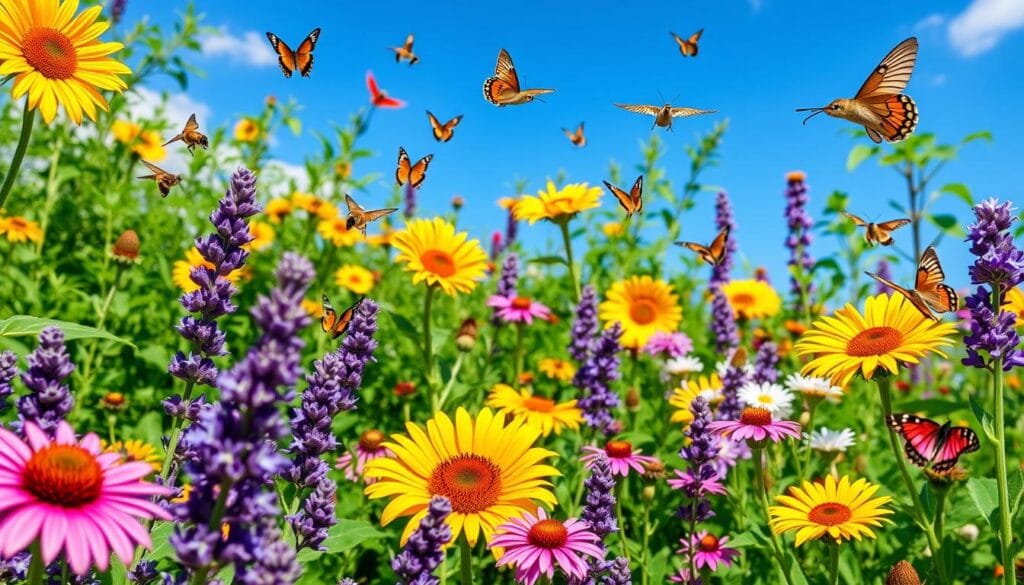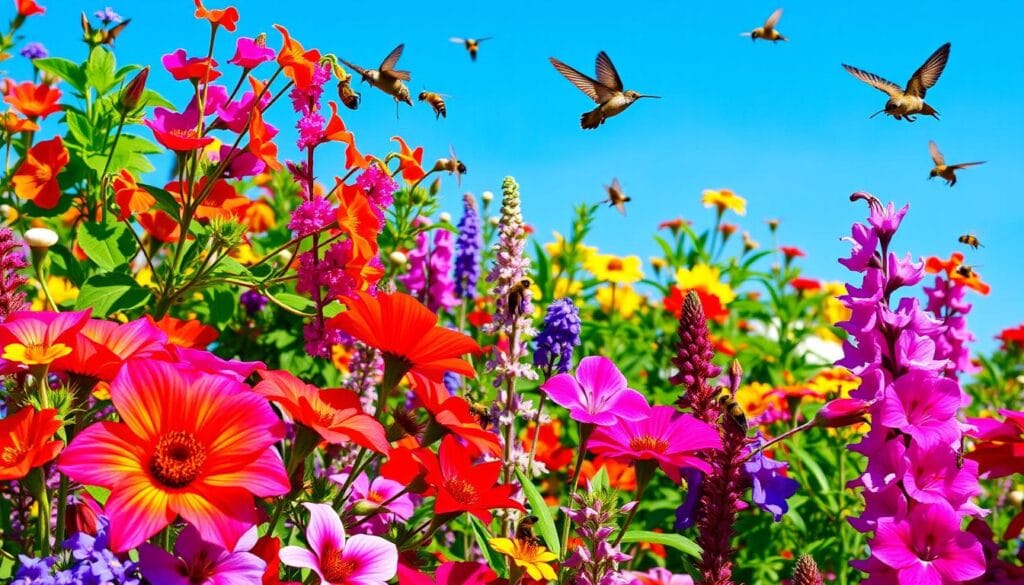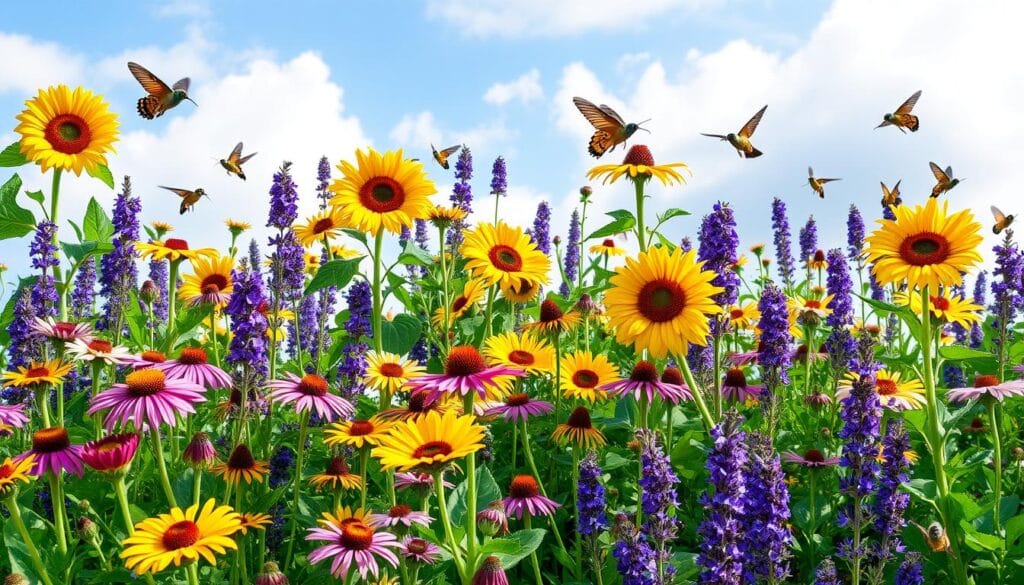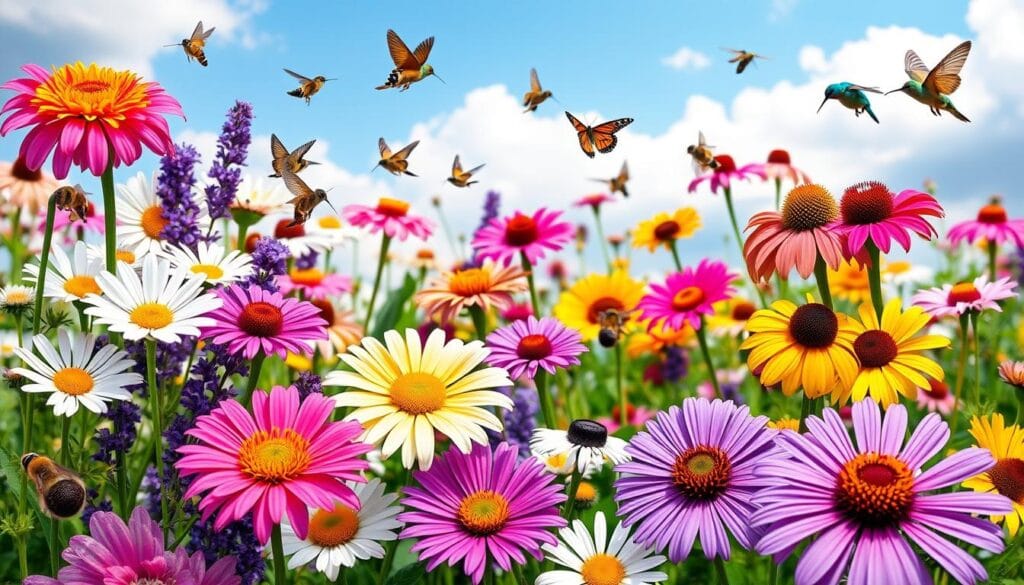When you enter your garden, you see vibrant colors and smell sweet fragrances. These flowers play a big role in attracting bees, butterflies, and hummingbirds. By planting pollinator-friendly plants, you help create a healthy garden ecosystem. This attracts vital creatures and supports their survival.

Flowers like dogwoods, winterberry bushes, and goldenrod are great for attracting pollinators. They offer nectar and pollen, which bees, butterflies, and hummingbirds need to thrive. Adding these plants to your garden can greatly help the local ecosystem.
Key Takeaways
- Planting pollinator-friendly plants is crucial for attracting bees, butterflies, and hummingbirds.
- Flowers That Attract Pollinators, such as dogwoods and goldenrod, are perfect for creating a thriving ecosystem.
- Pollinator-friendly Plants provide the necessary nectar and pollen for pollinators to survive.
- Native plants, like bee balm and asters, are over 4 times more attractive to bees than non-native plants.
- Choosing the right flowers can make a significant difference in supporting the local ecosystem.
- By creating a pollinator-friendly garden, you can support the survival of these vital creatures.
Why Pollinators Are Important for Our Ecosystem
Pollinators like bees, butterflies, and hummingbirds are key to our ecosystem’s health. By planting Bee-friendly Flowers and making your garden welcoming, you support these important creatures. Over 80% of the world’s flowers need pollinators to grow, and 75% of crops do too. This shows how vital they are for our food.
Some of the key benefits of pollinators include the following:
- Pollinators help pollinate about 75% of crop plants worldwide, including most fruits and grains.
- They make fruits bigger, more uniform, and tastier, improving our food quality.
- Bees and flies pollinate over 130 types of fruits and veggies we eat.
By understanding pollinators’ importance and supporting them, like planting native plants and avoiding harmful pesticides, you help agriculture and ecosystems thrive. Next, we’ll look at bees’ role in pollination and how to make your garden bee-friendly.
Top Flowers for Attracting Bees
Creating a garden that attracts pollinators starts with the right flowers. Bees are drawn to Pollinator Attracting Blooms with lots of nectar and pollen. Lavender, sunflowers, and coneflowers are among the best choices.
Lavender: A Bee Favorite
Lavender is a favorite of bees because it’s fragrant and easy to care for. It grows well in many conditions.
Sunflowers: Bright and Beneficial
Sunflowers are perfect for bees because they offer lots of nectar and pollen. They’re also easy to grow and brighten up any garden.
Coneflowers: Easy to Grow
Coneflowers are a hit in pollinator gardens. They’re simple to grow, come in many colors, and attract bees and butterflies.
Adding these flowers to your garden helps support local pollinators. Make sure to pick a mix of Flowers That Attract Pollinators that bloom at different times. This way, you’ll have a steady supply of nectar and pollen all season.
Best Flowers for Butterflies
Creating a garden that attracts butterflies and bees is key. Flowers like milkweed, zinnias, and marigolds are great choices. They offer nectar and pollen, helping these creatures thrive.
To attract different butterflies, plant a variety of flowers. Butterflies love flat-topped or clustered flowers. They’re drawn to red, orange, yellow, or pink blooms. Here are some flowers that butterflies can’t resist:
- Milkweed: essential for monarch butterflies
- Zinnias: a colorful choice that attracts a variety of butterfly species
- Marigolds: simple and effective, blooming all summer
By adding these flowers to your garden, you’ll create a haven for butterflies. Choose plants native to your area. They’ll provide food and shelter for these beautiful creatures. With some planning, you can make your garden a haven for butterflies and bees, helping your local ecosystem.
Flowers That Attract Hummingbirds
Creating a garden that attracts hummingbirds is key. These birds love plants with tubular shapes and lots of nectar. This makes them perfect for Pollinator-friendly Plants. Some top choices include bee balm, salvia, and fuchsia.
Hummingbirds also like daylilies, columbines, and pineapple sage. These plants offer nectar and nutrients, which are great for hummingbird gardens. Research shows that 75% of these plants need full sun, while 5% prefer full shade with morning sun.

- Tubular shapes
- Rich nectar
- Bright colors
- Long-lasting blooms
Adding these flowers to your garden makes it welcoming for hummingbirds. With 50% of these plants being annuals and 50% perennials, you have many choices.
By planting Pollinator-friendly Plants and Flowering Plants for Pollinators that attract hummingbirds, you help these pollinators. Your garden will also be beautiful and full of life. Make sure to pick plants that fit your USDA zone and get enough sun.
Native Plants for Local Pollinators
Creating a pollinator-friendly garden means choosing plants native to your area. Pollinator-friendly plants attract bees, butterflies, and hummingbirds. Native species support local ecosystems and boost biodiversity.
Native plants like milkweed, wild bergamot, and purple coneflowers are both beautiful and beneficial. They offer nectar and pollen to pollinators.
Here are some Flowers That Attract Pollinators:
- Milkweed: a vital food source for monarch butterflies
- Wild bergamot: a favorite of bees and butterflies
- Purple coneflowers: a popular choice for pollinator gardens
Adding native plants to your garden helps local pollinators thrive. Choose plants that fit your region and climate. For advice, talk to a local nursery or gardening expert.
| Native Plant | Region | Pollinators Attracted |
|---|---|---|
| Milkweed | Continental U.S. | Monarch butterflies, bees |
| Wild bergamot | Nearly all 50 states | Bees, butterflies |
| Purple coneflowers | Eastern and central U.S. | Bees, butterflies, hummingbirds |
Creating a Pollinator Garden
Creating a pollinator garden is a great way to help these important creatures. By adding Pollinator Attracting Blooms to your garden, you can make a safe space for bees, butterflies, and hummingbirds.
Designing Your Garden for Pollinators
To make your garden pollinator-friendly, follow these tips:
- Choose flowers that bloom at different times to offer nectar and pollen all season.
- Use native plants, as they attract native pollinators more than non-native ones.
- Plant flowers in groups to help pollinators find nectar and pollen easily.
Choosing the Right Location and Soil
When picking a spot for your garden, think about sunlight and soil. Most plants need full sun to partial shade and good drainage.

Seasonal Blooming for Continuous Support
Plant a mix of flowers that bloom at different times to keep pollinators fed and sheltered all year.
| Season | Flowers |
|---|---|
| Spring | Coneflowers, Sunflowers, Lavender |
| Summer | Zinnias, Marigolds, Bee Balm |
| Fall | Asters, Chrysanthemums, Sedum |
Flower Colors That Attract Pollinators
When you’re setting up a garden for pollinators, think about the colors of flowers. Pollinator-friendly plants and Flowering Plants for Pollinators should match the colors that attract them. Bees, for instance, love blue, purple, violet, white, and yellow. They use their vision to find nectar in these colors.
Here’s a list of colors and flowers that pollinators find most appealing:
- Blue: Veronica spicata ‘Novaverblu’ PP26602, Heliotropum amplexicaule ‘Azure Skies’
- Purple: Verbena ‘Princess Dark Lavender’, Salvia hybrid ‘Amistad’
- Yellow: Sunflowers, Zinnias
- White: Sweet Alyssum, Bee Balm
By choosing a mix of Pollinator-friendly plants in various colors, you make your garden both stunning and useful. It becomes a safe space for Flowering Plants for Pollinators and the creatures they draw in.
The Best Time to Plant Pollinator Flowers
Planting Flowers That Attract Pollinators at the right time is key for a successful pollinator garden. Knowing your region’s unique needs helps provide nectar and pollen all season long.
Seasonal Considerations for Different Regions
Regions have different seasons that affect when to plant Attracting Blooms. In cold areas, plant early spring flowers to feed pollinators when they wake up.
Understanding Bloom Times
Knowing when flowers bloom is crucial for a pollinator garden. Mix flowers that bloom at different times to keep food available all season.
Ensuring Year-Round Support
To help pollinators all year, plant flowers that bloom in every season. This way, pollinators always have food and shelter, even in winter. Some good choices include:
- Crocuses, which bloom in early spring
- Sunflowers, which bloom in late summer
- Asters, which bloom in fall

By using these tips and planting a variety of Flowers That Attract Pollinators, you can make a garden that supports pollinators all year.
| Flower | Bloom Time | Region |
|---|---|---|
| Crocus | Early Spring | Northern Regions |
| Sunflower | Late Summer | Southern Regions |
| Aster | Fall | Eastern Regions |
Maintaining Your Pollinator-Friendly Garden
To keep your pollinator-friendly garden thriving, it’s key to maintain it well. This means watering and fertilizing your Pollinator-friendly Plants often. Also, controlling pests without harming pollinators is crucial. By doing these things, you can make a garden that’s both lovely and useful. It will also be a healthy place for Flowering Plants for Pollinators.
Here are some tips for maintaining your pollinator-friendly garden:
- Water your plants deeply but infrequently to encourage deep root growth.
- Fertilize your plants with a balanced fertilizer to promote healthy growth.
- Control pests using natural methods, such as introducing beneficial insects or using physical barriers.
- Prune your plants regularly to promote better blooms and prevent overgrowth.
By following these tips, you can keep your garden a haven for Pollinator-friendly Plants and Flowering Plants for Pollinators. Always choose plants native to your area. They should offer nectar and pollen for pollinators.
With the right care, your garden can be a beautiful and useful space for you and pollinators. Plant a variety of Flowering Plants for Pollinators and follow these tips. This way, you support local pollinators and help the ecosystem.
| Plant Type | Pollinator Attracted | Maintenance Tips |
|---|---|---|
| Native Flowers | Bees, Butterflies, Hummingbirds | Water deeply, fertilize regularly, prune annually |
| Herbs | Bees, Butterflies | Water regularly, fertilize lightly, prune frequently |
| Shrubs | Hummingbirds, Butterflies | Water deeply, fertilize regularly, prune annually |
Common Mistakes in Pollinator Gardens
Creating a garden for Attracting Pollinators requires avoiding common mistakes. These mistakes can harm these beneficial insects. Knowing these pitfalls helps create a safe space for pollinators.
Using too many pesticides is a common error. These chemicals can hurt pollinators. Instead, try natural pest control methods like diatomaceous earth or a mixture of dish soap and water. Also, don’t ignore the changing seasons. They affect which plants bloom and which pollinators visit.
Avoiding Harmful Practices
To make a Pollinator Attracting Blooms garden, don’t plant non-native species. They can crowd out native plants and harm local ecosystems. Choose native plants that fit your area and climate.
- Overusing pesticides
- Ignoring seasonal changes
- Planting non-native species

By avoiding these mistakes, you can build a pollinator garden that thrives. It will be a safe and supportive place for these vital insects.
| Mistake | Effect on Pollinators |
|---|---|
| Overusing pesticides | Harmful to pollinators |
| Ignoring seasonal changes | Affects types of plants in bloom and pollinators present |
| Planting non-native species | Harms local ecosystems |
The Future of Pollinators and Our Gardens
Thinking about the future of pollinators in our gardens is key. Over half of North America’s bee species are declining, with 1 in 4 at risk of extinction. Creating a pollinator-friendly garden with native plants like Serviceberry and Coreopsis can help.
Adding Pollinator-friendly Plants to your garden is a great step. Plants like sunflowers and lavender are perfect for attracting pollinators. Also, Flowers That Attract Pollinators like zinnias and marigolds can brighten up your garden while helping pollinators.
Community efforts to support pollinators are crucial. Together, we can create a network of gardens that are safe for pollinators. Ways to get involved include:
- Planting native flowers in your garden
- Supporting local conservation efforts
- Reducing pesticide use and creating a bee-friendly environment
Every small action we take can help the future of pollinators and our gardens. Remember, together, we can make a big difference in supporting these vital creatures.
Resources for Learning More about Pollinators
Creating a pollinator garden is rewarding and impactful. There are many resources to help you learn more. You can find books, workshops, and online courses to deepen your knowledge of Attracting Blooms and Flowering Plants for Pollinators.
Books and Online Courses
Discover pollinators through books like The Beekeeper’s Garden by Marcia Tatroe. “Attracting Beneficial Bugs to Your Garden” by Jessica Walliser is also great. Online courses from the Xerces Society and the National Gardening Association teach you how to create pollinator-friendly gardens.
Local Gardening Clubs and Workshops
Joining local gardening clubs is a great idea. Attend workshops by Bee City USA or Bee Campus USA to learn from experts. These groups share tips on the best Attracting Blooms and native plants for your area.
National Organizations and Their Missions
Many national organizations protect pollinators. The Xerces Society, the Pollinator Partnership, and the U.S. Fish and Wildlife Service are leading the way. Visit their websites to learn how you can help protect these vital species.
Pollinator-Friendly Gardening FAQ
Why are pollinators important for our ecosystem?
Pollinators like bees, butterflies, and hummingbirds play a crucial role in plant reproduction, supporting biodiversity and food production.
What are the top flowers for attracting bees?
Bees love lavender, sunflowers, and coneflowers due to their abundant nectar and pollen.
Which flowers are best for attracting butterflies?
Butterflies are drawn to milkweed, zinnias, and marigolds for nectar and host plants.
What types of flowers do hummingbirds prefer?
Hummingbirds prefer brightly colored, tubular flowers like bee balm, salvia, and fuchsia.
Why should I choose native plants for my pollinator-friendly garden?
Native plants support local pollinators and improve ecosystem stability by providing suitable food and habitat.
When is the best time to plant flowers that attract pollinators?
The best time varies by climate, but planting throughout the season ensures continuous nectar availability.
What are some common mistakes to avoid in a pollinator-friendly garden?
Avoid excessive pesticide use, planting non-native species, and neglecting seasonal plant diversity.
Source Links
- 16 Pollinator Plants That Will Attract Birds, Bees, and Butterflies to Your Garden – https://www.marthastewart.com/1537920/how-attract-birds-pollinators-garden
- Best Flowers for Bees: 15 Native Plants That Attract Bees – https://zerowastehomestead.com/best-flowers-for-bees-15-native-plants-that-attract-bees/
- Why We Need Pollinators for a Thriving Ecosystem – https://melomys.com/blogs/sustainable-living/why-we-need-pollinators-for-a-thriving-ecosystem?srsltid=AfmBOorwFA1w7hJjzVt7g7Uc5Go1tOu359csntS5AjziNphqi12PFR9s
- Mother Lovin, Ecosystem Education for Kids: Lets talk about Pollinators! — WildKind – https://www.wildkindinc.com/blog/bees-butterflies-and-blooms-the-importance-of-pollinators-to-our-ecosystems
- The 7 Best Flowers for Honeybees | Honeybees Favorite Flowers — Buddha Bee Apiary – https://www.buddhabeeapiary.com/blog/what-flowers-do-honeybees-like
- These Gorgeous Flowering Plants Make Bees Buzz with Joy – https://www.countryliving.com/gardening/g32157369/flowers-that-attract-bees/
- 5 Full-Sun Plants to Attract Pollinators to Your Garden | Fairview Garden Center – https://fairviewgardencenter.com/blog/hot-plants-pollinators/
- How to Attract Pollinators | Gardener’s Supply – https://www.gardeners.com/how-to/attracting-butterflies-hummingbirds/7265.html?srsltid=AfmBOorNKUAiy3BXl9epTnIutUaXaOFPIg8f7lqNPhXeLfX5UmNfT9SO
- 35 Gorgeous Flowers That Will Attract Butterflies to Your Garden – https://www.realsimple.com/home-organizing/gardening/outdoor/flowers-that-attract-butterflies
- 7 Plants and Flowers That Will Attract Hummingbirds to Your Garden – https://www.marthastewart.com/7690105/best-garden-plants-attract-hummingbirds
- Plant These Gorgeous Flowers to Attract Hummingbirds – https://www.countryliving.com/gardening/g32196978/flowers-that-attract-hummingbirds/
- Top 10 Native Plants for Your Pollinator Garden – https://www.lawnstarter.com/blog/landscaping/best-pollinator-garden-plants/
- Gardening for Pollinators: Top Native Plants in California – https://www.groworganic.com/blogs/articles/gardening-for-pollinators-top-native-plants-in-california?srsltid=AfmBOoqYiZ4q22QqJgKBuUDpFsujS1Ut4b1znXAdnA4Fyz-fARhqXzDF
- How Can We Help Pollinators?: Tips to Draw Bees and Other Pollinators – https://zerowastehomestead.com/how-to-attract-pollinators-to-your-garden/
- How to Create a Pollinator Garden – Dennis’ 7 Dees | Landscaping Services & Garden Centers – https://dennis7dees.com/creating-a-pollinator-garden/
- Attract Bees To Your Garden With These Vibrant Flowers – https://www.southernliving.com/garden/flowers-that-attract-bees?srsltid=AfmBOoofcjbgcPAHYNTikCjIr3eMKjbfg5j0XX2UDWqynIa0YAtEgyxA
- 20 Beautiful Flowers That Attract Bees and Other Pollinators – https://www.veranda.com/outdoor-garden/g39124056/flowers-that-attract-bees/
- 14 Pollinator Plants to Bring Color to Your Garden – https://www.thecommons.earth/blog/14-pollinator-plants-to-bring-color-to-your-garden
- Pollinator Gardens | University of Maryland Extension – https://extension.umd.edu/resource/pollinator-gardens
- Plant These 13 Bulbs in the Fall to Attract Pollinators in the Spring – https://www.bhg.com/gardening/flowers/bulbs/bulbs-for-pollinators/
- 15 Pollinator Flowers for Fall Gardens (& Bulbs to Plant Now!) – https://zerowastehomestead.com/fall-flowers-to-plant-for-late-season-pollinators-and-pollinator-bulbs-to-plant-in-fall/
- Create a Pollinator-Friendly Garden – https://washoecounty.gov/sustainability/take-action/pollinator-friendly-garden.php
- Essential Pollinator Gardening: A Beginner’s Guide – https://www.bathgardencenter.com/post/pollinator-gardening
- 5 Pollinator-Friendly Ways You Can Manage Garden Pests | U.S. Fish & Wildlife Service – https://www.fws.gov/story/5-pollinator-friendly-ways-you-can-manage-garden-pests
- Six Common Mistakes in Native Gardening – Golden Gate Bird Alliance – https://goldengatebirdalliance.org/blog-posts/six-common-mistakes-in-native-gardening/
- Master’s of Disguise: How Plants Dress Up for Pollinators – https://butterflies.org/masters-of-disguise-how-plants-dress-up-for-pollinators/
- Give Bees a Chance: Creating your own pollinators garden – Powerlines – https://powerlines.seattle.gov/2024/04/12/give-bees-a-chance-creating-your-own-pollinators-garden/
- How Flowering Plants Attract Pollinators – https://piedmontmastergardeners.org/article/how-flowering-plants-attract-pollinators/
- Pollinators and Urban Farming: A Year of Learning and Growing – The National Wildlife Federation Blog – https://blog.nwf.org/2024/09/pollinators-and-urban-farming-a-year-of-learning-and-growing/
- Pollinator Conservation Program – https://www.xerces.org/pollinator-conservation
- Nature Notes: Pollinators – The Heroes of the Plant World – The Ridges Sanctuary – https://ridgessanctuary.org/nature-notes-pollinators-the-heroes-of-the-plant-world/
- The Ultimate Guide to Planting Roses in Clay Soil






